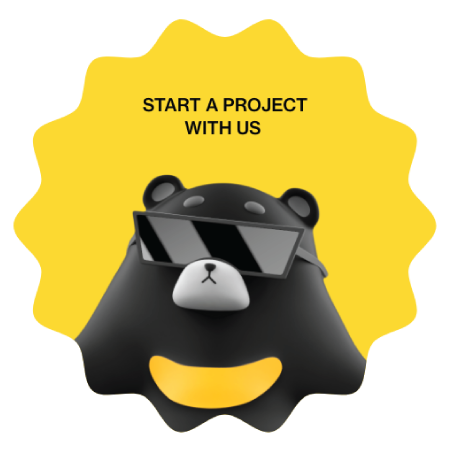You’ve officially launched your website. You’ve got everything down – a stunning colour palette, an attractive font, creative animations and eye-grabbing product photos. All in all, you’ve handled your web design well.
However, you might be unsure of how your website’s design aligns with your brand. Branding and web design should work together to create a unique and recognizable online presence, enhancing your company's identity and SEO rankings. A consistent brand identity in web design connects better with the right audience, leading to more conversions and leads.
This article will lay out the link between branding and website design and how you can achieve brand consistency in your web design.
What is Branding in Website Design?
Website branding is the process of combining different design elements together to create a distinct, consistent and memorable brand identity for your website. In essence, the main purpose of website branding and design is to convey a specific message, evoke emotions, and build brand recognition among visitors.
Do web designers do branding?
To put it simply, while a web designer will use a company’s brand identity to develop a website, they do not create the branding themselves. A web designer’s main role is devising a strategy to achieve the business's goals through its online distribution channel, the website.
Why is Branding Important in Web Design?
Branding is essential for your business’s identity, telling your company's story, resonating with your audience, and standing out from the competition. Effective branding leaves a lasting impression through recognisable colours, creative logos, and catchy slogans.
Website branding extends your brand continuity online, strengthening your reputation, adding authority, and creating familiarity with your company's mission and values across digital platforms.
Website branding grants the following benefits for your business:
- Influences purchasing decisions: Consumers are more likely to buy a product from a brand that they recognise or trust.
- Creates an identity for your business: In an increasingly crowded market, having a strong, consistent brand identity will give your customers something to relate to and connect with. This, in turn, increases the likelihood of them returning to you instead of going towards a competitor.
- Makes your business memorable: Branding is the face of your company, and having a distinct brand identity helps customers distinguish your business from the competition.
- Builds trust and credibility: Trust is a big hurdle for many small or new businesses. By establishing a strong brand and connecting with your audience, you can quickly gain their trust.
- Brand loyalty: Customers and clients want brands that align with their personalities. To achieve that, you must ensure that every interaction generates a positive and memorable user experience.
- Brand Equity: The amount of sway and trust your brand has in the minds of consumers. A website with strong brand recognition can generate sales simply by raising brand awareness and creating positive user experiences.
- Boosts advertising and marketing: Branding supports your marketing and advertising efforts, adding an extra punch to your promotions.
How to Apply Branding to a Website? A Definitive Guide
Now that you understand the importance of integrating website and branding design, it is time to master incorporating brand consistency into your website design process.
This guide offers the best ways to achieve a cohesive brand identity for your website, helping you harmonize your brand image with your site’s design.
-
Define your brand identity
First, determine your brand identity to ensure a consistent design aesthetic that reflects your company's message and personality. Harmonising these features is a key aspect of establishing your brand personality:
Visual identity: Your brand's visual language presents a consistent aesthetic across every touchpoint.
Logo: A logo is symbolic of your brand and helps visitors instantly recognise you when entering your website. The ideal spot should be at the top left of your site, as most languages are read left to right. Other important places include the website footer, contact page, blogs, and any purchase confirmation page.
Brand colours: Using your brand colours throughout your website is a good way to enhance the user experience. For example, if your brand colours are blue and white, you may want these colours in some parts of your website, but not necessarily as a font colour.
Typography: Fonts can be a more effective means of conveying your brand identity than the text itself. That said, you should limit yourself to 3 different fonts at most and ensure that they follow a clear visual hierarchy to balance out your text better.
Imagery/photography: Pictures are worth a thousand words, so it is important to pick high-quality photos or illustrations that speak to your target audience and put your brand identity front and centre.
Templates: To streamline the website branding process, consider using a website template that matches your particular industry.
-
Use compelling content
For your website to succeed, it must produce a compelling brand message, convincing readers to buy your product. To do so, you must speak directly to your target audience, highlighting the key features, benefits, and values that make your brand unique and how your product or service solves their problems.
Here are some content you can use to get your brand message across a wide range:
Website copy (and microcopy like CTAs)
Slogans
Blog posts
Email newsletters
Chatbots
Brand story (‘About us’ section)
Downloadable content
Regardless of how you communicate it, your brand voice must always be present, and your customers must be able to recognise it instantly.
-
Create a user-friendly layout
Users want to make their purchases as quickly as possible, and the best method of doing so is to provide a clean and intuitive layout that guides visitors along their e-shopping journey, granting them a seamless user experience.
Here are the standard pages to include when you’re planning the structure of your website:
Homepage: Essentially, your homepage is the entrance to your website. It should communicate what you do, who you are, and how your product or service can help.
About: This page tells your brand story and values and highlights the people behind your business.
Product or service pages: If you offer more than one product or service, you should create separate pages for each.
Location information: If you have a physical store or office, providing an address, directions, and a map will enable visitors to find your location details easily.
Frequently Asked Questions (FAQs) page: Customers seeking answers to commonly asked questions by customers can be directed to this page, saving time for your customer support team.
Policy page: Whether you’re a small startup or a massive multinational corporation, you must have a page to display vital documentation, like a privacy policy.
Contact page: This is where visitors can contact you. In addition to your contact details, you can add links to your social media accounts.
Above all else, ensure that your web pages are easily navigable, following a clear hierarchy that places the most important details at the top while providing additional info or a call to action at the bottom.
-
Design for mobile-friendliness
In this mobile-focused era, a person’s first introduction to your brand will likely take place on their mobile device, which means you must optimise your site for responsive web design (or mobile-friendliness) accordingly.
Here are a few key steps to improve your website branding’s mobile performance:
Optimising for mobile-first indexing
Minimising or hiding page elements for mobile
Using CTAs for effective navigation
Adding a “Back to Top” button
Hyperlinking your logo to the website’s homepage
Using mobile-friendly menus like hamburger menus
Integrating mobile features
-
Establish brand trust
Building trust through website branding is crucial, especially for new audiences. Integrate social proof, such as positive customer reviews, testimonials, case studies, and awards, into your site.
Showing your product/service prices upfront can also communicate your trustworthiness.
Most importantly, be transparent. Customers will only trust a brand that is truthful towards them.
-
Establish an emotional connection with the audience
Branding is more than just about informing people of your product or service. Branding should create an emotional connection, associating your brand with positive feelings. Use website design with images, photography, animations, and interactive elements to engage visitors and make them feel part of your brand's story. Learn more about how you can improve your brand’s worldbuilding.
-
Provide a memorable user experience (UX)
The user experience is the lifeblood of every good website. If your visitors are upset with your website, they will not return and, thus, will not remember your brand fondly.
Creating the right user experience involves effective usage of the above steps, plus the following key elements:
Customer service: Excellent customer service is instrumental in retaining customers and enhancing their user experience. It is the bridge connecting your brand identity with your consumer base.
Customer pain points: Optimal user experience is built on addressing your customer’s pain points. Everything, from the price of your products to the time it takes to finish their purchases, can influence a shopper’s online experience.
Website personalisation: Personalising the shopper’s experience is an example of UX best practices. For example, you can provide intuitive product recommendations to visitors or allow them to save their preferences for future visits. These simple features will make your customers feel like your site is specifically built for their needs and preferences.
-
Keep your website up-to-date
Your work doesn’t stop at completion. Just as you nurture your brand, so too you must give the same care and attention to your website’s maintenance and upkeep.
Regular website maintenance includes updating content, fixing broken links, ensuring proper performance, and keeping visuals fresh. It also involves security updates, uptime monitoring, SEO optimization, and general support. Regularly updating your site is essential for ensuring a positive user experience and maintaining a strong SEO ranking.
-
Have a strong call to action
A call to action (CTA) is a vital opportunity for guiding visitors along your desired path. After all, there’s no point in creating a beautiful website if your shoppers don’t know what to do next.
Displaying a clear and compelling CTA will help personalise your shoppers’ user experience and guide them along your brand story.
Another effective CTA is using promotions or discounts to attract and retain customers. By ascribing value to your brand, you’ll build trust with new visitors who are initially hesitant to embrace your product/service, leading to new conversions and lead generations.
-
Maintain consistency
Branding consistency is key. If your website is not consistent with your brand identity, even the most eye-catching visuals, helpful content, and persuasive call to action won’t make an impact. Ensure every customer feels a seamless experience. Ultimately, you want every customer to feel like they are walking into a brick-and-mortar store, from the purchasing all the way to the unpacking.
What’s more, you can’t control where your consumers are coming in from. One customer may come in from a social media post, while another might have searched for your URL on their tablet. Both expect to find the same excellent site performance and functionality as everyone else.
Hence, aligning website design with brand identity reinforces a unified brand image and recognition.
Importance of Outsourcing Branding and Website Design Services
If you need help aligning your brand identity with your website design, consider outsourcing to a branding and website design agency. They will consult you on the best ways to apply your branding in a manner that complements your web design.
Through such a partnership, you’ll receive specialised knowledge in UI/UX design, SEO optimisation, and other key aspects of website design, leading to an enhanced user experience for your customers that drives lead generation and brand recognition. And in the process, you’ll also save time and money on the branding and website design process.
Leverage on Branding and Website Design Packages
Branding and website design packages are bundles of e-commerce website design and branding services. They are designed to provide easy branding and website design for creatives, streamlining the process of creating a high-quality and engaging website. Many B2B branding and website design companies offer packages tailored to a range of needs and budgets, catering for both startups and established businesses.
How to choose a branding and website design company?
The ideal branding and website design studio works in your specific industry, has proven experience and expertise, is a team player with good, jargon-free communication, and is affordable without compromising on quality.
Conclusion
Whether you’re a tech startup or an e-commerce company, the most important step in establishing your company is creating a recognisable brand identity. Branding is how you distinguish yourself from the crowd, attract new customers, build a loyal consumer base, and generate organic traffic that raises your SEO ranking.
Start a branded website….. with Bikebear!
When it comes to creating immersive online experiences, Bikebear is your go-to branding and website design company. Our team has worked with companies, big and small, to build websites oozing with their brand identity. When you partner with us, you, too, will have a site that speaks your brand out loud.
Interested in building a branded website with us? Then contact us now, and we’ll start working on your website branding as soon as possible.





